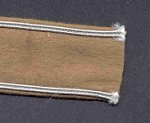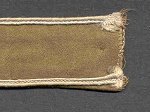
by COL Scott Pritchett
FAKES AND REPRODUCTIONS
As with most Third Reich awards, the AFRIKA cuffband was already in reproduction shortly after the end of the war. Consequently, the earliest reproductions almost certainly used some, or all, original wartime materials. These will only be detected by very close inspection and are often altogether impossible to tell. However, the vast majority of forgeries are not well executed and are relatively easy to detect. Documenting all variations of reproductions and fakes is a challenge, as they are numerous. Described herein are the common reproductions collectors will run up against. There exists forgeries that are quite close the original as can be seen below. Pictured below is one of the best fakes available today. The example shown was obtained from the Far East. The side-by-side comparison of the original (top) against the fake (bottom) should be informative.
| Side by side comparison of a fake (top) and
original (bottom) obverse/front
Click on images to enlarge |
|
e inspection and are often altogether impossible to tell. However, the vast majority of forgeries are not well executed an
| Side by side comparison of a fake (top) and
original (bottom) reverse.
Click on images to enlarge |
|
| Side by side comparison of a fake (top) and
original (bottom) ends.
Click on images to enlarge |
|
Modern fakes tend to use polyester materials throughout, including the embroidery thread, soutache braid, stitching and even the base cloth. Reproductions exist where the base material is felt or a linen type cloth, semi-rough burlap cloth, or even a webbed polyester material – almost looking like rip-stop nylon. The often referenced ‘burn test’ is a good means to make a determination on the composition of the materials used. While not always a 100% guaranteed method to determine originality on cloth items in general, in the case of the AFRIKA cuffband, it can be stated with a high degree of certainty that the standard issue band was not made of materials that melt when heat is applied. Threads from the composition of an original, issued style AFRIKA band should burn to ash.
|
|
| A poor quality fake. Many such reproductions can be marketed as private purchase or POW made. While either are possible in this particular case, I believe this to be a reproduction. As noted, original AFRIKA cuffbands are only scarce rather than rare and a collector has a good chance of obtaining a regulation, issue piece so, does not have to guess on pieces such as this one. Below is the reverse of the poor quality copy. |
|
|
In terms of actual construction, fakes usually exhibit some easily detected mistakes. First, the embroidered lettering is usually the wrong size - with letters that are most often too short - and will be embroidered too thin in width. Letters are almost never formed correctly either, with the 'R' and 'K' being especially bad. The poor formation might be in the construction of the letter, for example the stem of the' K' may angle wrong because it is too short, or the curvature of the 'R' may bulge too much. In other variations, the letter endings do not exhibit the correct flair or serif. In some cases the letters are completely blocked with no serif at all to the ends.
The palm trees are also seldom up to standard. On the low-end fakes, the most common mistake is often the actual embroidery of the palm leaf veins in a different color thread (such as black). On originals the palm centers are not embroidered at all, but rather created by leaving the center of the leaves slightly hollow. The high quality fakes will capture this detail quite convincingly, but on close inspection, may be seen to leave too little space open. However, collectors do not need to be overly concerned with these versions, as the execution of the remainder of these cuffbands will let down the entire piece.
The Russia braid on reproductions is often set in from the edge
slightly, rather than being tangent to it as an original should show.
Fake Russia braid is usually slightly thinner than original braid. The
easiest detail to pick up on is that fake Russia braid/soutache is often
the wrong color, being a darker, charcoal gray rather than a
silver-gray. A dead give away is that the braid will be a different
color – usually a lot darker - than that of the title embroidery. On
originals, the color of the soutache is visually identical to that of
the embroidery. Some fakes are hand embroidered, using bullion, instead
of machine embroidered in cotton. Those out of Pakistan especially rely
on this technique. Hand embroidery will usually incorporate a
linen-looking backing that extends and covers across the entire
embroidery. In some fakes, this backing covers the entire reverse of the
cuffband. This backing exists in white and black and the effect is to
make the cuffband extremely stiff, almost cardboard like. While it
cannot say categorically that original, hand embroidered, bullion
versions did not exist (they probably did in very small numbers), the
issued style described and pictured in this article is by far the most
numerous and is in fact, the standard issue piece collectors should
seek. As these cuffbands are only scarce (as opposed to being rare),
they are obtainable by collectors with a little patience, care and time.
Consequently, a collector need not risk adding a fake bullion version to
their collection, or leaving it up to varied opinions, by guessing at a
variation example. Of course, any variant coming with thorough
provenance would be a different story. Recently there appears to have
been discovered, and now sold on the market by several dealers, several
batches of unissued pieces. Those observed display obvious and heavy
storage wear and tear, looking dirty and stained, but nonetheless, are
original pieces. Thorough study, patience and an objective approach to
collecting should get the average collector past the fakes and able to
locate and own an original.
Award documents are also reproduced and faked. Virtually every award
document is these days. However, one should be especially on guard when
considering high-end awards and those to elite units such as
Fallshirmjäger, Feldherrnhalle, Großdeutschland, Waffen SS, and panzer
soldiers. Forgers for some reason seem prone to select more highly
decorated soldiers when forging all manner of high and low award
documents, so be wary of Knights Cross holders being awarded EK Is or
various campaign decorations. Fortunately for the collector, these are
easier to research than and award to the average soldier. In the case of
the AFRIKA cuffband award document, it is recommended that the buyer
look very closely at Fallshirmjäger documents, because of their
desirability, and anything making direct reference to the Duetsches
Afrika Korps, as Heer documents were issued to soldiers as members of
the Panzerarmee and not the DAK. Forgeries are usually done on original
blank award forms, to make the challenge more daunting. Consequently,
the collector should arm him/herself with a variety of resources that
enable them to check the validity of the entries as a primary means to
determine originality. Does the date of the award make sense? Was the
authorizing official in command of that headquarters at the time of
issue, etc. etc.? Some data will be difficult to verify. Thus another
area to check is the type set being used (there are differences between
wartime and more modern typewriters in the size and formation of letters
that one can learn to discern by looking at enough original and fake
documents), the type of pen or pencil (the Germans did not have ball
point pens, for example, and quite often signed in colored pencil), and
the spelling of typed words and abbreviations (for example, many times
what looks like a capital “J” as used as “Jnf.”, is the typical
abbreviation of ‘infantry’). Of course, German military typewriters had
a runic key for making SS. But any AFRIKA band to an SS soldier should
be considered exquisitely rare and thus, viewed with a very critical
eye. For all intents and purposes, the Waffen and Allgemeine SS did not
participate in North Africa, as already mentioned. Some sources make
note of an SS police organization having served in Tunis. This is
probably true. However, the vast majority of these rare awards were made
to soldiers that escaped the surrender and subsequently transferred to
the SS after their return.
Wehrpaß and Soldbuch entries are also faked. These forgeries are seldom complete fabrications from blank documents, however. Most often, the existing information is doctored to include an award that was never received (thus increasing the attractiveness and price of the document) and/or a unit that was never served in. This latter case is the most difficult for the forger to be convincing at, as service entries were pretty much made in chronological order. Any later entries would require significant erasing or would be noticeably out of sequence. The Soldbuch was the soldier's paybook and, as such, remained with him and carried on his person. These typically exhibit more wear and tear than the Wehrpaß, which was a unit record that stayed with the unit's (usually the company) administration and transferred with the soldier. In North Africa, the Soldbuch would not fit in the tropical shirt or the trouser pocket without having to be somehow damaged, so it was carried in the tunic pocket. There was a special rate of pay for soldiers serving in North Africa, so one should expect to see such an entry made on the page showing payment scales in a genuine tropical Soldbuch. The standard entry was "Inhaber hat am (date) afrikanischen Boden betreten" (holder arrived in Africa on such and such date). The details of assignment were found on page 4, however soldiers were given orders to remove this page when capture was imminent. This would be something a forger might overlook if the book purported to be that of a former POW. Nor did the Soldbuch used in Africa carry a photograph of the owner (a practice begun in 1943) as continental books did later in the war when a more positive means of identification became necessary. The Luftwaffe paybook was almost identical, except it was covered In a Luftwaffe blue cover and not the tan color used by the Heer. It also carried a Luftwaffe eagle on the cover and also had a page pasted on the inside cover that gave guidance in the form of "Ten Commandments for the Conduct of War by German Soldiers". The Kriegsmarine Soldbuch was similar to the Heer version. Collectively, these distinguishing characteristics may help the collector determine whether or not a particular Soldbuch is or is not fabricated.
The Wehrpaß is also faked and, being much less scarce than the Soldbuch, probably more commonly seen being tampered with. The information contained inside was largely different and completed the soldier's total official service record. For the collector interested in the award of the AFRIKA cuffband, the books contain information on awards on page 23, units served with beginning on page 12, campaigns and battles beginning on page32 (often a type-written page(s) pasted in place of or in addition to hand-written entries) and any special training beginning on page 20. All branches of service used identical books, the only difference usually being a stamp on the front cover designating the branch of service. Any of these locations of information are targets for the forger. A gain, one should look closely at the chronology, how the entries were made (typed, stamped, hand, pen or pencil, etc.), what units were served in and how the awards square with the service in battles and campaigns.
![]()
© Copyright Wehrmacht-Awards.com LLC |



